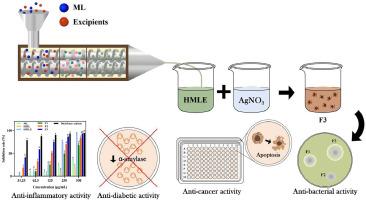Green synthesis of silver nanoparticles from mulberry leaf through hot melt extrusion: Enhanced antioxidant, antibacterial, anti-inflammatory, antidiabetic, and anticancer properties
IF 5.1
Q1 CHEMISTRY, APPLIED
引用次数: 0
Abstract
In this study, mulberry leaf (ML) extract, along with ML processed by hot melt extrusion (HME) (HML), and ML processed by HME with biopolymer (HMLE), were utilized for the eco-friendly synthesis of silver nanoparticles (AgNPs). The physicochemical properties of AgNPs synthesized from ML, HML, and HMLE extracts were characterized using UV–Vis spectrophotometry, zeta potential analysis, transmission electron microscopy (TEM), dynamic light scattering (DLS), energy dispersive spectroscopy (EDS), X-ray diffraction (XRD), and Fourier transform infrared spectroscopy (FT-IR). HME processing enhanced the active ingredients in the ML extract and increased the reduction efficiency of Ag ions. In the ABTS radical scavenging activity assay, AgNPs synthesized from HMLE (F3) exhibited the highest antioxidant activity with the lowest IC50 value. F3 also demonstrated the lowest minimum inhibitory concentration (MIC) and minimum bactericidal concentration (MBC) against Escherichia coli and Staphylococcus aureus. In the disk diffusion test, F3 showed the largest zone of inhibition, indicating the highest antimicrobial activity. In the anti-inflammatory assay using albumin inhibition, F3 achieved the highest inhibition rate, followed by the HMLE extract. In contrast, the extract group exhibited no activity in the antidiabetic test, while the AgNPs group showed the highest antidiabetic activity in F3. Additionally, F3 demonstrated the most potent anticancer activity against breast cancer cells, resulting in the lowest cell viability. Overall, this study suggests that AgNPs synthesized using ML extract enhanced via HME processing exhibit superior physiological activities compared to those synthesized using unprocessed ML extract.

通过热熔挤压从桑叶中绿色合成银纳米粒子:增强抗氧化、抗菌、抗炎、抗糖尿病和抗癌特性
本研究利用桑叶(ML)提取物、经热熔挤压(HME)处理的 ML(HML)和经 HME 与生物聚合物(HMLE)处理的 ML(HML),以生态友好的方式合成银纳米粒子(AgNPs)。利用紫外可见分光光度法、zeta 电位分析、透射电子显微镜(TEM)、动态光散射(DLS)、能量色散光谱(EDS)、X 射线衍射(XRD)和傅立叶变换红外光谱(FT-IR)对用 ML、HML 和 HMLE 提取物合成的 AgNPs 的理化性质进行了表征。HME 处理增强了 ML 提取物中的活性成分,并提高了银离子的还原效率。在 ABTS 自由基清除活性实验中,由 HMLE(F3)合成的 AgNPs 表现出最高的抗氧化活性和最低的 IC50 值。F3 对大肠杆菌和金黄色葡萄球菌的最低抑菌浓度(MIC)和最低杀菌浓度(MBC)也最低。在盘扩散试验中,F3 的抑菌区最大,表明其抗菌活性最高。在使用白蛋白抑制的抗炎试验中,F3 的抑制率最高,其次是 HMLE 提取物。相比之下,提取物组在抗糖尿病试验中没有表现出活性,而 AgNPs 组在 F3 中表现出最高的抗糖尿病活性。此外,F3 对乳腺癌细胞的抗癌活性最强,细胞存活率最低。总之,这项研究表明,与使用未加工的 ML 提取物合成的 AgNPs 相比,使用通过 HME 加工增强的 ML 提取物合成的 AgNPs 具有更高的生理活性。
本文章由计算机程序翻译,如有差异,请以英文原文为准。
求助全文
约1分钟内获得全文
求助全文

 求助内容:
求助内容: 应助结果提醒方式:
应助结果提醒方式:


